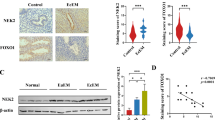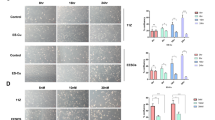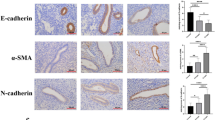Abstract
Endometriosis is an estrogen-dependent pro-inflammatory disease that affects 6% to 10% of reproductive-age women. Current treatments target sex steroids, and none are disease-specific. MicroRNA treatments have provided promising results for some chronic diseases and cancers. We have previously shown microRNA 451a is increased in endometriosis and that elevation of 451a contributes to the pathophysiology of the disease. Here, we propose inhibition of miR-451a for the treatment of endometriosis in a murine model. Endometriosis was treated using a microRNA 451a inhibitor or a scrambled control microRNA. Treatment with miR-451a inhibitor resulted in reduced endometriosis lesion size (30 vs 13 mm3). There was no difference in the number of visible lesions between the miR-451a treatment and controls. Treatment led to altered expression of several genes including YWHAZ, CAB39, MAPKI, β-catenin, and IL-6. Systemic treatment with a miR-451a inhibitor is a promising therapy for endometriosis that simultaneously affects multiple pathways driving the disease.
Similar content being viewed by others
References
Falcone T, Flyckt R. Clinical management of endometriosis. Obstet Gynecol. 2018;131(3):557–571.
Nematian SE, Mamillapalli R, Kadakia TS, Majidi ZM, Moustafa S, Taylor HS. Systemic inflammation induced by microRNAs: endometriosis-derived alterations in circulating microRNA 125b-5p and Let-7b-5p regulate macrophage cytokine production. J Clin Endocrinol Metab. 2018;103(1):64–74.
Bulun SE. Endometriosis. N Engl J Med. 2009;360(3):268–279.
Macer ML, Taylor HS. Endometriosis and infertility: a review of the pathogenesis and treatment ofendometriosis-associated infertility. Obstet Gynecol Clin North Am. 2012;39(4):535–549.
Casper RF. Introduction: a focus on the medical management of endometriosis. Fertil Steril. 2017;107(3):521–522.
Friedman RC, Farh KK, Burge CB, Bartel DP. Most mammalian mRNAs are conserved targets ofmicroRNAs. Genome Res. 2009;19(1):92–105.
Pan Q, Luo X, Toloubeydokhti T, Chegini N. The expression profile of micro-RNA in endometrium and endometriosis and the influence of ovarian steroids on their expression. Mol Hum Reprod. 2007;13(11):797–806.
Ghazal S, McKinnon B, Zhou J, et al. H19 lncRNA alters stromal cell growth via IGF signaling in the endometrium of women with endometriosis. EMBO Mol Med. 2015;7(8):996–1003.
Burney RO, Hamilton AE, Aghajanova L, et al. MicroRNA expression profiling of eutopic secretory endometrium in women with versus without endometriosis. Mol Hum Reprod. 2009;15(10):625–631.
Laudanski P, Charkiewicz R, Kuzmicki M, Szamatowicz J, Char-kiewicz A, Niklinski J. MicroRNAs expression profiling ofeuto-pic proliferative endometrium in women with ovarian endometriosis. Reprod Biol Endocrinol. 2013;11:78.
Laudanski P, Charkiewicz R, Tolwinska A, Szamatowicz J, Char-kiewicz A, Niklinski J. Profiling of selected microRNAs in pro-liferative eutopic endometrium of women with ovarian endometriosis. Biomed Res Int. 2015;2015:760698.
Cho S, Mutlu L, Grechukhina O, Taylor HS. Circulating micro-RNAs as potential biomarkers for endometriosis. Fertil Steril. 2015;103(5):1252–1260.e1.
Seifer BJ, Su D, Taylor HS. CirculatingmiRNAsinmurine experimental endometriosis. Reprod Sci. 2017;24(3):376–381.
Hu Z, Mamillapalli R, Taylor HS. Increased circulating miR-370-3p regulates steroidogenic factor 1 in endometriosis. Am JPhysiol Endocrinol Metab. 2018;316(3):E373–E382.
Hawkins SM, Creighton CJ, Han DY, et al. Functional microRNA involved in endometriosis. Mol Endocrinol. 2011;25(5):821–832.
Grechukhina O, Petracco R, Popkhadze S, et al. A polymorphism in a let-7 microRNA binding site of KRAS in women with endo- metriosis. EMBO Mol Med. 2012;4(3):206–217.
Nothnick WB, Graham A, Holbert J, Weiss MJ. miR-451 deficiency is associated with altered endometrial fibrinogen alpha chain expression and reduced endometriotic implant establishment in an experimental mouse model. PLoS One. 2014;9(6): e100336.
Joshi NR, Su RW, Chandramouli GV, et al. Altered expression of microRNA-451 in eutopic endometrium of baboons (Papio anu-bis) with endometriosis. Hum Reprod. 2015;30(12):2881–2891.
Cosar E, Mamillapalli R, Ersoy GS, Cho S, Seifer B, Taylor HS. Serum microRNAs as diagnostic markers of endometriosis: a comprehensive array-based analysis. Fertil Steril. 2016;106(2): 402–409.
Lee B, Du H, Taylor HS. Experimental murine endometriosis induces DNA methylation and altered gene expression in eutopic endometrium. Biol Reprod. 2009;80(1):79–85.
Laschke MW, Korbel C, Rudzitis-Auth J, et al. High-resolution ultrasound imaging: a novel technique for the noninvasive in vivo analysis of endometriotic lesion and cyst formation in small animal models. Am J Pathol. 2010;176(2):585–593.
Kim BG, Yoo JY, Kim TH, et al. Aberrant activation of signal transducer and activator of transcription-3 (STAT3) signaling in endometriosis. Hum Reprod. 2015;30(5):1069–1078.
Graham A, Falcone T, Nothnick WB. The expression of microRNA-451 in human endometriotic lesions is inversely related to that of macrophage migration inhibitory factor (MIF) and regulates MIF expression and modulation of epithelial cell survival. Hum Reprod. 2015;30(3):642–652.
Trattnig C, Ucal M, Tam-Amersdorfer C, et al. MicroRNA-451a overexpression induces accelerated neuronal differentiation of Ntera2/D1 cells and ablation affects neurogenesis in micro-RNA-451a-/- mice. Plos One. 2018;13(11):e0207575.
Wang W, Zhang L, Wang Y, et al. Involvement of miR-451 in resistance to paclitaxel by regulating YWHAZ in breast cancer. Cell Death Dis. 2017;8(10):e3071.
Ruhl R, Rana S, Kelley K, et al. microRNA-451a regulates color-ectal cancer proliferation in response to radiation. BMC Cancer. 2018;18(1):517.
Sun X, Zhang H. miR-451 elevation relieves inflammatory pain by suppressing microglial activation-evoked inflammatory response via targeting TLR4. Cell Tissue Res. 2018;374(3):487–495.
Nothnick WB, Falcone T, Joshi N, Fazleabas AT, Graham A. Serum miR-451a levels are significantly elevated in women with endometriosis and recapitulated in baboons (Papio anubis) with experimentally-induced disease. Reprod Sci. 2017;24(8): 1195–1202.
Sahin C, Mamillapalli R, Yi KW, Taylor HS. microRNA Let-7b: a novel treatment for endometriosis. JCellMolMed. 2018;22(11):5346–5353.
Author information
Authors and Affiliations
Corresponding author
Rights and permissions
About this article
Cite this article
Li, M., Zhou, Y. & Taylor, H.S. miR-45la Inhibition Reduces Established Endometriosis Lesions in Mice. Reprod. Sci. 26, 1506–1511 (2019). https://doi.org/10.1177/1933719119862050
Published:
Issue Date:
DOI: https://doi.org/10.1177/1933719119862050




